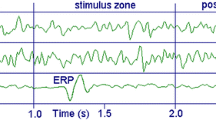Abstract
The topographic analysis of electrical brain activity consists of the extraction of quantitative features which adequately describe the scalp recorded electrical fields of the brain. In the beginning of brain electrical activity mapping most methods centered mainly around the graphical display of multichannel EEG and evoked potential data. Meanwhile quantitative analysis strategies have been developed, and such methods are applied to topographic EEG and evoked potential data enabling the statistical evaluation of the effects of different experimental conditions as well as the comparison of various clinical populations. Major new analysis techniques comprise the computation of global field power and global dissimilarity for determination of components of evoked potential fields, the segmentation of map series by topographical features, time range analysis, FFT approximation for the spatial analysis of EEG frequency bands as well as correlation analysis and spatial principal components analysis (Spatial PCA). Data from experiments dealing with evoked brain activity will illustrate the application of these quantitative methods that also can be used for the analysis of the spontaneous EEG.
Similar content being viewed by others
References
Donchin, E. A multivariate approach to the analysis of average evoked potentials. IEEE Trans. Bio-med. Eng., 1966, 13: 131–139.
Duffy, F.H., Jones, K., Bartels, P., McAnulty, G. and Albert, M. Unrestricted principal components analysis of brain electrical activity: issues of data dimensionality, artifact, and utility. Brain Topography, 1992, 4: 291–307.
Glaser, E.M. and Ruchkin, D.S. Principles of neurobiological signal analysis. New York: Academic Press, 1976.
Harman, H.H. Modern factor analysis (2nd ed.) Chicago: The University of Chicago Press, 1967.
Lehmann, D. and Michel, C.M. Intracerebral dipole source localization for FFT power maps. Electroenceph. clin. Neurophysiol., 1990, 76: 271–276.
Lehmann, D. and Skrandies, W. Reference-free identification of components of checkerboard-evoked multichannel potential fields. Electroenceph. clin. Neurophysiol., 1980, 48: 609–621.
Lehmann, D. and Skrandies, W. Time segmentation of evoked potentials (EPs) based on spatial scalp field configuration in multichannel recordings. Electroenceph. clin. Neurophysiol., 1986, Suppl. 38: 27–29.
Skrandies, W. Latent components of potentials evoked by visual stimuli in different retinal locations. Int. J. Neurosci., 1981, 14: 77–84.
Skrandies, W. Visual evoked potential topography: methods and results. In F.H. Duffy (Ed.), Topographic Mapping of Brain Electrical Activity, Butterworths, Boston, 1986: 7–28.
Skrandies, W. The upper and lower visual field of man: electrophysiological and functional differences. Progress in Sensory Physiology, 1987, 8: 1–93.
Skrandies, W. Time range analysis of evoked potential fields. Brain Topography, 1988, 1: 107–116.
Skrandies, W. Data reduction of multichannel fields: global field power and principal components. Brain Topography, 1989, 2: 73–80.
Skrandies, W. Global field power and topographic similarity. Brain Topography, 1990, 3: 137–141.
Skrandies, W. and Lehmann, D. Spatial principal components of multichannel maps evoked by lateral visual half-field stimuli. Electroenceph. clin. Neurophysiol., 1982, 54: 662–667.
Skrandies, W., Chapman, R.M., McCrary, J.W. and Chapman, J.A. Distribution of latent components related to information processing. Ann. N.Y. Acad. Sci., 1984, 425: 271–277.
Author information
Authors and Affiliations
Rights and permissions
About this article
Cite this article
Skrandies, W. EEG/EP: New techniques. Brain Topogr 5, 347–350 (1993). https://doi.org/10.1007/BF01128688
Accepted:
Issue Date:
DOI: https://doi.org/10.1007/BF01128688




